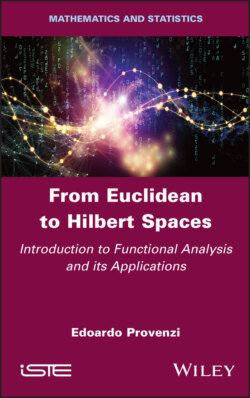Читать книгу From Euclidean to Hilbert Spaces - Edoardo Provenzi - Страница 18
1.4. Generalized Pythagorean theorem
ОглавлениеThe Pythagorean theorem can be generalized to abstract inner product spaces. The general formulation of this theorem is obtained using a lemma.
LEMMA 1.1.– Let (V, 〈, 〉) be a real or complex inner product space. Let u ∈ V be orthogonal to all vectors v1, . . . , vn ∈ V . Hence, u is also orthogonal to all vectors in V obtained as a linear combination of v1, . . . , vn.
PROOF.– Let , be an arbitrary linear combination of vectors v1, . . . , vn. By direct calculation:
□
THEOREM 1.8 (Generalized Pythagorean theorem).– Let (V, 〈, 〉) be an inner product space on . Let u, v ∈ V be orthogonal to each other. Hence:
More generally, if the vectors v1,. . . , vn ∈ V are orthogonal, then:
PROOF.– The two-vector case can be proven thanks to Carnot’s formula:
Proof for cases with n vectors is obtained by recursion:
– the case where n = 2 is demonstrated above;
– we suppose that (recursion hypothesis);
– now, we write u = vn and , so u ⊥ z using Lemma 1.1. Hence, using case n = 2: ‖u + z‖2 = ‖u‖2 + ‖z‖2, but:
so:
and:
giving us the desired thesis.
Note that the Pythagorean theorem thesis is a double implication if and only if V is real, in fact, using law [1.6] we have that ‖u + v‖2 = ‖u‖2 + ‖v‖2 holds true if and only if ℜ(〈u, v〉) = 0, which is equivalent to orthogonality if and only if V is real.
The following result gives information concerning the distance between any two vectors within an orthonormal family.
THEOREM 1.9.– Let (V, 〈, 〉) be an inner product space on and let F be an orthonormal family in V . The distance between any two elements of F is constant and equal to .
PROOF.– Using the Pythagorean theorem: ‖u + (−v)‖2 = ‖u‖2 + ‖v‖2 = 2, from the fact that u ⊥ v.□
